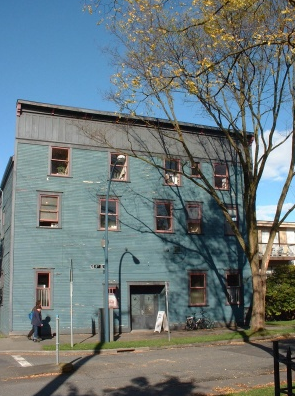Museum in a Hat
 Tuesday, November 29, 2011 at 12:33PM
Tuesday, November 29, 2011 at 12:33PM (*Museum in a Hat refers to a performance by the artist Robert Filliou during which he would pull things out of a hat and give the objects to other performers or onlookers. The objects were in constant transition as was the museum. Filliou had a profound influence on the avant-garde movement in Canada during the late 1960’s and early 1970’s. Filliou’s performance was described to me by Hank Bull, one of the founders of The Western Front an alternative artist-run centre in Vancouver, Canada which will be celebrating its 38th anniversary in 2011.

“I am interested in performance as a double-jointed anti-genre in perpetual crisis.”[1] The speaker is Judy Radul.
“…these voices [with reference to a performance at The Western Front entitled, One Fine Evening] spoke to as much as they spoke through the performers. Pre-recorded voices ordered them about, slogans sprouted from their mouths incongruously, speech was accented, patriarchal, computer generated, motivationally enhanced, theoretically implanted, and, in general, authorially skewed.”[2]
Vancouver and its Cultural Landscape
a
sustaining vision of
the intricate palimpsest-of-relationships
supporting every living/dying
thing ought to inform an enlightened polis;
to imagine oneself interacting
with everything (imaginable) at a strategic
moment: pen, brush, spear to hand
is simply what it’s always been about [3]
This poem by Roy Kiyooka exemplifies many of the themes which have been at the heart of the extraordinary artistic output of The Western Front (hereafter referred to as WF) over the last twenty-four years. Kiyooka plays with the idea of the palimpsest both as a metaphor of erasure and as a way of keeping history present through the traces of our culture’s work with ‘pen, brush and spear’. Nothing ever disappears in this processing of events and of history. Cultural activity builds on the past, even as that past changes with every artistic interpretation of it. Kiyooka was part of a large group of artists, performers, poets and intellectuals who shaped the modernist movement in Vancouver in the 1960's and early 1970's. It was out of this activity that the Western Front was created in 1973. In addition to Kiyooka, Robert Filliou and Ray Johnson were formative influences on the WF. “Ray Johnson visited Vancouver once briefly in 1969 as a guest of the UBC Fine Arts Gallery for an international exhibition of visual/verbal concrete poetry and correspondance art, entitled, Concrete Poetry — an exhibition in four parts which also included contributions by Robert Filliou and the internatiional Fluxus community. Filliou’s first visit was in the summer of 1973 when he came as a guest of the newly founded Western Front Society. The work of both artists, often deliberately ephemeral, used puns, riddles, events and performances to convey ideas….For Filliou, research was the door through which anyone could enter and participate in the creative process. Artists could think of themselves as researchers influencing the culture.”[4]
History and art, the ability to imagine the impossible, to make the real and the imaginary mix, to make the everyday a work of art and to make art a part of the everyday were not just thematic explorations for Kiyooka, Filliou and the many other major artists and performers who came to the WF in the early days. They were at the heart of their sensibilities as artists. The transformation of art from an object-oriented enterprise to a lived experience for artist and community alike is what has defined the WF throughout its history. In some respects, the WF was developed as a community centre with both a service and an artistic mandate. To this day, its facilities are open to booking from members of the community and its festivals and events are attended by a diverse and largely heterogeneous group of people. The WF has a strong sense of the local with an equally profound understanding of the international art scene and a connection into worldwide activities which it has imported into Vancouver on a regular basis.
If you are interested in reading the rest of this essay, please contact me at r bur nett at ecuad dot ca
[1]Judy Radul, “You Don’t Say: Voices from the Incongruous Outside,” Catalogue for the Exhibition/Performance, One Fine Evening, Curator, Eric Metcalfe, The Western Front, Vancouver (1996), n.p.
[2] Ibid.
[3] Roy Kiyooka, “Notes Toward a Book of Photoglyphs,” Capilano Review , Second Series: 2 (Spring 1990): 80 quoted in The Verbal and the Visual, Collapse #2, Vancouver Art Forum Society (1996): 55.
[4] Michael Morris and Vincent Trasov, “Letter from Berlin,” in Robert Filliou: From Political to Poetical Economy, Exhibition catalogue, Morris and Helen Belkin Art Gallery, 1994, pp.72-73.



